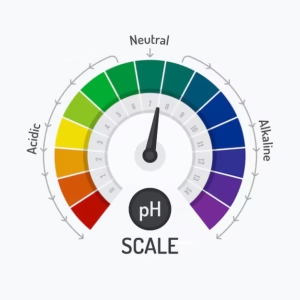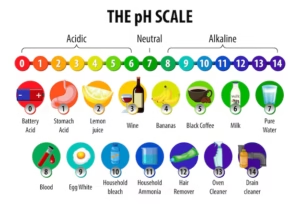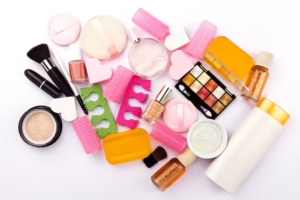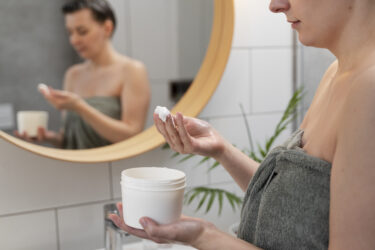The Science of pH in Skincare and Cosmetics:
Introduction:
Have you ever wondered why some skincare products leave your skin glowing while others cause irritation, even if they’re labeled “natural” or “for sensitive skin”? Or why your hair feels frizzy after using a new shampoo, despite promises of “smoothness”? The secret lies in a tiny two-letter term: pH, pH in Skincare and Cosmetics.
Often overlooked, pH is the invisible force that determines how products interact with your skin and hair. From the effectiveness of anti-aging serums to the strength of your hair cuticle, pH plays a starring role.
In this guide, we’ll explore the science-backed relationship between pH and beauty, how to choose pH-balanced products, and why ignoring this factor could damage your skincare and hair care routines.
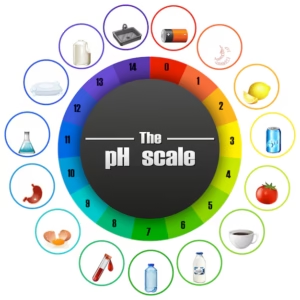
Why pH Matters in Skin Care and Hair Care:
pH—short for “potential hydrogen”—is a scale from 0 to 14 that measures how acidic or alkaline a substance is. Your skin and hair aren’t neutral; they thrive in specific pH ranges.
Straying too far from these ranges disrupts their natural defenses, leading to dryness, breakouts, frizz, and even infections. For example:
- Skin’s Natural pH: A slightly acidic 4.5–5.5 creates the “acid mantle,” a protective barrier against bacteria and pollution.
- Hair’s Ideal pH: A 4.5–5.5 pH keeps cuticles sealed, locking in moisture and shine.
Using products outside these ranges—like alkaline bar soaps (pH 9–11) or overly acidic toners (pH <3)—can strip natural oils, weaken barriers, and cause long-term damage. Let’s break down the science step by step.
Understanding pH in Skincare and Cosmetics: The Basics:
What Is pH?
Developed in 1909 by Danish chemist Søren Sørensen, the pH scale quantifies the concentration of hydrogen ions in a solution. Here’s a quick reference:
- 0–6.9: Acidic (e.g., lemon juice, vinegar).
- 7: Neutral (pure water).
- 7.1–14: Alkaline (e.g., baking soda, soap).
Why Skin and Hair pH Are Unique:
Human skin and hair evolved to thrive in mildly acidic environments. Here’s why:
- Skin’s Acid Mantle: This thin, protective film is a mix of sebum (oil), sweat, and natural moisturizing factors. Its slightly acidic pH (4.5–5.5) serves three critical functions:
- Blocks Pathogens: Harmful bacteria and fungi struggle to survive in acidic conditions.
- Locks in Moisture: Strengthens the skin barrier to prevent water loss.
- Supports Enzymes: Enzymes responsible for shedding dead skin cells work optimally at pH 5.5.
- Hair’s Cuticle Structure: Hair cuticles—the outermost layer—act like shingles. At pH 4.5–5.5, they lie flat, reflecting light and retaining moisture. High pH (alkaline) products force them open, leading to dryness and breakage.
How pH Affects Skin Health:
The Acid Mantle: Your Skin’s First Defense:
Imagine the acid mantle as your skin’s personal shield. When intact, it:
- Neutralizes alkaline irritants (e.g., pollution, harsh cleansers).
- Prevents transepidermal water loss (TEWL), a key factor in hydrated skin.
- Hosts beneficial microbes that fight acne-causing bacteria.

What Happens When pH Rises?
Using high-pH products (e.g., traditional soap with pH 9–11) disrupts this delicate balance. A 2018 study in Clinical Dermatology found that washing skin with alkaline cleansers:
- Increased TEWL by 25%, causing dryness.
- Raised skin pH for up to 90 minutes, leaving it vulnerable to bacteria.
- Reduced ceramide production, weakening the barrier over time.
Long-Term Consequences of High pH:
- Dryness & Sensitivity: Stripped of natural oils, skin becomes tight and prone to redness.
- Acne & Infections: Harmful bacteria like S. aureus thrive in alkaline environments.
- Premature Aging: A compromised barrier accelerates collagen breakdown, leading to wrinkles.
pH and Haircare: Beyond the Surface
The Hair Cuticle Connection
Hair is made of keratin proteins held together by hydrogen bonds. Its pH determines whether cuticles stay smooth or lift:
- Low pH (Acidic): Seals cuticles, boosting shine and reducing frizz. Apple cider vinegar rinses (pH 2–3) are a popular example.
- High pH (Alkaline): Opens cuticles, causing dryness and breakage. Bleaching (pH 8–10) lifts cuticles to deposit color but damages hair over time.
How Common Treatments Affect Hair pH
- Coloring & Bleaching: Alkaline agents (pH 8–10) open cuticles to alter pigment. Repeated use weakens hair structure.
- Heat Styling: High heat + alkaline products = brittle, porous hair.
- Clarifying Shampoos: Often pH 6–7.5; overuse can strip natural oils.
Active Ingredients and Their Ideal pH Levels
Why pH Determines Ingredient Efficacy
Skincare actives are like Goldilocks—they need pH to be “just right” to work. For example:
- Hyaluronic Acid: Best at pH 4.5–5.5. At higher pH, its moisture-binding capacity drops by 40% (Journal of Cosmetic Science, 2017).
- AHAs (Glycolic/Lactic Acid): Require pH 3–4 to exfoliate. At pH >4, they lose potency.
- Retinol: Stable at pH 5–6. Lower pH degrades it into irritating retinoic acid.
Key Ingredients and Their pH Ranges:
| Ingredient | Optimal pH | Why It Matters |
| Vitamin C | 3–3.5 | Oxidizes rapidly if pH rises above 3.5. |
| Niacinamide | 5–7 | Works across a wide range but loses efficacy in extreme pH. |
| Salicylic Acid (BHA) | 3–4 | Penetrates pores best at low pH. |
Risks of Incorrect pH Pairings
- Using a pH 3 vitamin C serum with a pH 6 retinol cream? The retinol will neutralize the vitamin C, rendering both ineffective.
- AHAs at pH >4 become gentle humectants instead of exfoliants.
Alkaline vs. Acidic Products: What to Use When?
Cleansers and Soaps
- Problem: Traditional bar soaps (pH 9–11) strip the acid mantle.
- Solution: Opt for “syndet” cleansers (synthetic detergents) with pH 5.5–7. Brands like CeraVe and Cetaphil use syndets for gentle cleansing.
Exfoliants and Toners
- AHAs/BHAs: Require pH 3–4 to dissolve dead skin cells. The Ordinary’s Glycolic Acid Toner (pH 3.6) is a cult favorite.
- Toners: Post-cleansing, use a pH 5–6 toner (e.g., Klairs Supple Preparation) to restore skin’s balance.
How to Test pH at Home
Simple Methods for Consumers
- pH Strips: Dip into liquid products (toners, serums). Match the color to a chart.
- Digital pH Meters: Ideal for creams or gels. Brands like Apera Instruments offer affordable options.
Brands Promoting pH Transparency
- Paula’s Choice: Lists pH for all exfoliants.
- The Ordinary: Discloses pH levels on product pages.
- Krave Beauty: Formulates cleansers at pH 5.5.

pH and the Skin Microbiome: An Invisible Ecosystem
The Role of Good Bacteria
Your skin hosts trillions of microbes, including “good” bacteria like Staphylococcus epidermidis. These microbes:
- Produce antimicrobial peptides to fight pathogens.
- Reduce inflammation linked to acne and eczema.
- Strengthen the skin’s immune response.
For a deeper dive into how pH affects cosmetics and skincare, check out this detailed guide by Atlas Scientific: pH in Cosmetics.
How High pH Harms Microbial Balance
A 2020 study in the Journal of Investigative Dermatology found that alkaline skincare:
- Reduced microbial diversity by 30%.
- Allowed harmful bacteria like S. aureus to flourish, worsening eczema.
FAQs about pH in Skincare and Cosmetics:
1. Can I Use Multiple pH-Dependent Actives Together?
Avoid layering incompatible actives. For example:
- AM: Vitamin C (pH 3) → wait 20 mins → Niacinamide (pH 5–7).
- PM: AHA (pH 3–4) → wait 30 mins → Retinol (pH 5–6).
- Is “pH-Balanced” Just a Marketing Term?
Not always, but be skeptical. Look for specific claims like “pH 5.5” instead of vague terms. - Does Tap Water Affect Skin pH?
Yes! Hard water (pH 8–8.5) raises skin pH. - How Often Should I Check Product pH?
Test new products, especially exfoliants or vitamin C. Stable formulas (e.g., encapsulated retinol) retain pH over time.
The Takeaway: Smart pH in Skincare and Cosmetics Choices:
pH isn’t just a buzzword—it’s a non-negotiable factor for healthy skin and hair. Prioritize pH-balanced cleansers, pair actives wisely, and use pH strips to verify claims. Remember:
- Skin thrives at 4.5–5.5.
- Hair loves 4.5–5.5.
By aligning your routine with science, you’ll build resilience against irritation, aging, and environmental damage.Want to stay updated on the latest hair care innovations? Check out our guide on The Ultimate Guide to Hair Care Trends 2025 for insights into emerging ingredients and techniques.
